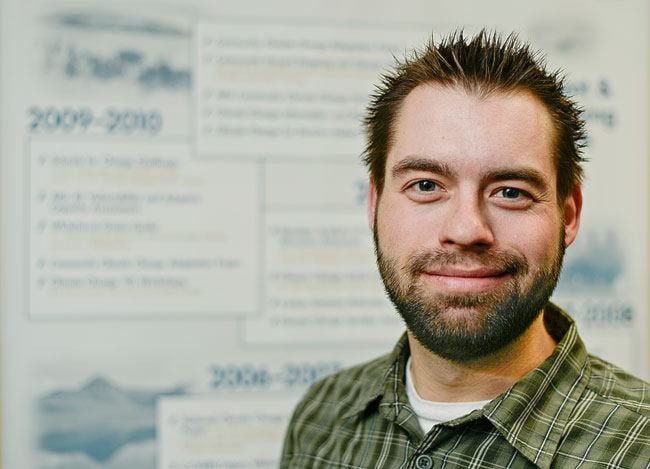Like a modern day William Ogilvie, one of the first men to improve on the crude fur trading maps of the Yukon, Philip Bonnaventure is building a better map of the territory.
But instead of traversing rivers in a basswood canoe to survey potential mineral wealth, Bonnaventure has been hiking up mountains to weather stations and using the data to map out the climate.
The project started in 2005.
Originally Bonnaventure, a climate scientist from Queen’s University, was studying permafrost in the mountains.
To do that he needed to log the average air temperature.
“We installed a lot of loggers in a whole bunch of different locations and they were meant to look at how temperature varied up mountains, in the frost above tree line,” he said.
What they found was unexpected.
The common assumption is that temperature goes down as the elevation goes up.
Scientists use an average of -6.5 degrees Celsius per 1,000 metres of elevation.
“I don’t want to call it a misconception, because it is true, but there are exceptions to those rules,” said Bonnaventure.
The Yukon’s mountains are among those exceptions.
“Oftentimes climatologists take a hard stance on a value of -6.5 degrees per 1,000 metres and instead we were finding in areas of the south that it was more gentle than that, maybe -2, -3 degree change per 1,000 metres,” he said. “We found this in the forest though, once you got above treeline it was actually -6.5, so the forest, the treeline, was a critical inflection point where things changed.”
What Bonnaventure proved out is something that most Yukoners already know: that it’s colder in the valleys than it is on the top of the mountains.
“In areas of the North approaching Faro and going north towards Dawson, we actually found that it was becoming inverted - that as you go up the mountain it became warmer, rather than colder,” he said.
It doesn’t happen everywhere in the Yukon, but when the geometry of the basin is right, denser cold air will migrate down to lower elevations. The stable air masses of the long, cold Yukon winters help make it all possible.
However, that only held true below the treeline. Above the treeline, the -6.5 degree per 1,000-metre average held true.
Bonnaventure was not the first person to discover this phenomenon, but he is the first person to incorporate it into climate maps.
Using the data that has been collected from the territory, mostly between 2006 and 2009, he was able to create a climate map of the territory that is much more accurate than anything that has been done before.
Most climate maps look on a large scale, using grid cells measured in kilometres.
“The thing is, the macro level doesn’t give us a lot of detail with respect to how things will change on the ground,” said Bonnaventure.
His climate maps solve that problem by improving the resolution by several orders of magnitude and bringing things down to a local level. Bonnaventure’s climate map uses grid cells measured 30 by 30 metres.
The maps he produced cover everything between 59 degrees latitude to 65 degrees latitude - an area of just under 500,000 square kilometres.
By using these more refined maps, Bonnaventure was able to model more accurate climate predictions for the Yukon 70 years into the future.
The idea is that it will allow policymakers to make better decisions and identify areas that are more vulnerable to climate change.
“If we could look at mining sites, for example - they are often located in higher-up areas located off the beaten track - we can see how they’re susceptible and this could go a long way to planning mitigation into the future,” said Bonnaventure. “We could see if it’s an area that’s currently frozen, if it’s an area that’s likely to stay frozen into the near future and the distant future.”
The maps could also be used to help predict how species of animals and plants will migrate, or how water will be affected as the climate changes.
It could also have applications in agriculture, said Bonnaventure.
“We know climate change is happening and it’s going to be a negative thing in certain aspects, but there will be some positives that come of it as well,” he said. “What we could do is look for what areas would be suitable for potential changes for things like agriculture and give us an opportunity to get an idea of how to manipulate crops into the future as well.”
These kinds of climate maps and models aren’t easy things to create.
Instead of sextants and telescopes to map things out, Bonnaventure needed to make use of massive computers to make all the calculations.
That’s where Yukon College came in.
The college hired a graduate student from Queen’s University, Graham Pope, to do most of the “grunt work.”
It was his job to input data into geomatic software to run the calculations that went into creating the climate maps.
In total it took about six months to make all the calculations, which was remarkably fast, said Bonnaventure.
Many of the environmental monitors that Bonnaventure used are still collecting data.
They were actually originally set up for a different project started by Bonnaventure’s former thesis advisor, Toni Lewkewicz, the dean of the faculty of arts at the University of Ottawa.
And the data is still being used for other projects.
Next month another scientist from Queen’s, Ryan Danby, will be up in Kluane with some students working on a project to understand how temperature changes are affecting things like the elevation of treelines.
And Bonnaventure has more work planned for the Yukon.
“The other thing I’m trying to understand is how vegetation plays a role in preserving permafrost,” he said. “I’d like to identify what areas are susceptible to thaw on short terms and which ones are susceptible longer term into the future.”
Contact Josh Kerr at
joshk@yukon-news.com
